After I got back from Israel in 1964 I got a job with Gestetner Ltd, the international office duplicator company. I started out as a chauffeur and ended up as Offset Service Manager for the City Branch. I also worked part-time as a mini-cab driver. That is another story.
I worked as a chauffeur for about 4 months, driving T.J. Smith, one of the partners. He thought I could do better and transferred me to the Offset Printing Division, headed by Denis Lathrop. I was trained by my manager, Ron Leeson, to be an offset printing machine problem solver and trainer. If there wasn’t a training class to teach, I would spend time travelling around the U.K helping local Gestetner branches solve their customers’ Offset Machine problems. When there were no problems I was either teaching at the Head Office in Tottenham, or I was a Service Engineer working out of the West End Branch in Euston.
The West End Branch area covered all of London, except for the City, which was covered by the City Branch in Curtain Road. Every day I would travel into Euston by public transport. From there I would be given my calls for the day. Generally I was given calls in and around the same area to cut down on travelling time to the jobsite. But it could still take an hour to get to the first call. The amount of time at each call would depend on the problem. If it was a service call then it could take an hour and a half to two and a half hours. If a part was needed I would have to return to the branch, pick up the piece and go back. The service engineers were allowed to claim for their fares to and from the branch. If we had two jobs next to each other we were allowed to claim two full return fares thereby giving us a bit of extra money. The extra money could amount to a few pounds a week. Quite a sum in those days when I was only earning £11 a week.
It occurred to me that if I had my own transportation I could whip around London and do several calls in a day. The fares that I could claim could easily add up to £10 a week. But there was a challenge. I would h ave to find and pay for parking, gas and insurance etc., oh, and a car. But as always, I had a plan! I had a moped before I left for Israel; I shall get one again. I bought a second-hand Puch moped for about £15 and a crash helmet and I was on my way. Zipping about London with my tool case strapped to the back, I was able to do many calls in a day. Of course my co-workers laughed at me in my moped crash helmet, but I had the last laugh on a Friday afternoon when I got my “fare money” back.
ave to find and pay for parking, gas and insurance etc., oh, and a car. But as always, I had a plan! I had a moped before I left for Israel; I shall get one again. I bought a second-hand Puch moped for about £15 and a crash helmet and I was on my way. Zipping about London with my tool case strapped to the back, I was able to do many calls in a day. Of course my co-workers laughed at me in my moped crash helmet, but I had the last laugh on a Friday afternoon when I got my “fare money” back.
One Friday afternoon I had nothing to do at work so I thought I would sneak out early and go home. As I was leaving with my helmet in hand and my raincoat on, the branch manager caught sight of me. “Where are you going Ross”, he demanded. “Oh, er, I’m just going to the washroom”, I replied quickly. “What with your raincoat on”, he asked. Before I could think, I said “Well there might be splash back.”. “Oh for goodness sake, go home”, he said and laughed and I was outta there.
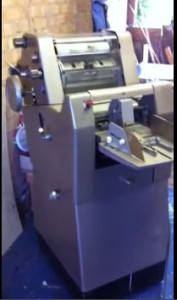
Because I had a moped I was the Service Engineer of choice for emergencies. Turning up within minutes of a call, I was a favourite with certain businesses. Some of the businesses asked me to work part-time and help them print especially difficult jobs. That’s how I worked part-time for a new charge card company called Eurocard. Eurocard had purchased a model 200. They were printing their first Eurocard directory in English and they were printing on onion skin paper. Onion skin paper was not really meant for Offset printing because of its light weight. To make matters worse the Gestetner 200 had a friction feed. A small rubber foot would come down and move the paper forward. The process was fraught with challenges based on the humidity of the paper and its light weight. So it needed an engineer to make it work. Took me several Saturdays and some evenings to print the directory, but eventually I got it done and the first Eurocard directory was ready. Would they give me a card? No. Oh well.
While I enjoyed fixing machines I knew there wasn’t much money to be made,but I had a plan to change that. I always had a plan. Most of them didn’t work. But you can’t learn from your successes; you can only learn from your mistakes.

This plan was a great plan. I had learned that most of the Offset printers were leased from a company called Mercantile Credit. Mercantile Credit had an office in the City. I called and found out that once the machines were returned at the end of the lease, they just sat in their basement. I found that I could buy one of these machines for £50. They were £500 new. The challenge was where could I keep the machine while I fixed it up? My mother’s younger brother Harry had a sewing machine company in Old St., London. But better than that he had a factory around the corner where he built his twin-tray fusing presses. Harry was my mother’s favourite and my surrogate dad. Harry was only too happy to help and gave me a corner of the factory to work in. So now I was rockin’ and rollin’. I brought in my first machine, probably using Harry’s van. As luck would have it there was a plating company and a spray painting company a few doors away. I sent all the parts to be re-plated and the machine covers out to be sprayed in a medium blue. I stripped the machine down, cleaned and re-assembled all the parts; put on the newly painted machine covers and we were ready for sales. The actual Gestetner colour was beige or khaki. My blue colour was much more stylish and couldn’t be confused with a new Gestetner machine.
I sold the rebuilt 201 models for £350 each and the rebuilt 200 models for £200. I sold quite a few of these rebuilt machines until Mercantile Credit found a better buyer for their used machinery. And that was that.
By that time I had machines in several print shops and was good friends with the owners. One owner in particular used to ask me to come in and work printing his material on the machines I had sold him. His material was, how shall I put it, for the Adult market. It wasn’t strictly porn; which was illegal at that time. They were considered “art books”. Lady Chatterley’s Lover was considered porn in those days. The books were aimed more at the bondage market. Boring! Never-the-less, I was earning money. The print shop had several offset printing machines. Some very large and some very small. The small machines were mainly printing the “art books”. There was some disagreement between printers as to whether the books were legal so any spoiled or unwanted pages were always shredded just in case. Today these books would be legal and just as boring. All the more confusing was that this was the era of “free love”. Carnaby Street and Chelsea were our Haight-Ashbury, flower power, make love not war. We had all the slogans, but no real freedom of expression. Anyway, I digress.
The road outside the print shop was being re-paved. In order to do the re-paving the parked cars needed to be moved. I had seen a Bobby (London policeman) entering the building to ask the occupants to move their cars. I followed up the stairs behind him. I already knew what was coming. This large Bobby stood in the doorway and said loudly above the machinery roar, “Oy does anyone have a car parked outside?”. No one heard what he said above the racket of the printing presses all they saw was a Bobby framed in the doorway. Suddenly, as if a whistle had been blown, machines were turned off, guys were running out the back door and metal printing plates were being ripped apart. Everyone, except the owner, was in a panic. With the machines off the Bobby was now able to be heard and repeated what he had said. There was an audible sigh of relief. One printer was actually laying over his machine in relief. The boss was calm and told the Bobby that all the cars would be removed. He left and I came in grinning from ear to ear. All the torn printing plates had to be replaced. The crazy thing was that the shredder was in full sight of the front door and the paper had been shredded short side in. This would have been correct had the printing been portrait and the book 8” by 10”, but a 5” by 4” pocket book was being printed and that was two pages on 8” by 10” paper and therefore landscape. What that meant was that long lines of shredded paper were coming out with complete sentences clearly visible and readable. Crazy stuff!
Glasgow
As I already stated, part of my duties were to trouble shoot and solve problems with offset printers that didn’t behave. I was often asked to go to such exotic places as Glasgow, Durham, Southampton and Folkeston. Usually I was at these places for a week. When asked by my manager whether I enjoyed being away visiting other parts of the UK I replied that while it was fun I couldn’t help thinking that if I was based in the U.S. I’d be travelling to Miami, L.A and New Orleans. Oh well, I had to make the best of it. The best of it was to see how many girls I could date in each branch I visited. My goal was a bird in every branch. I actually did achieve my goal except for Glasgow. What a place that was. I tell people I spent two weeks there one night. I flew up from London in a DeHaviland Comet. This was the first passenger jet airliner in the world. I felt very important, until I arrived at my hotel.
It was February, cold, dark and damp and I was put up at the Buchanan Street Station Hotel. It felt like I was staying right on the platform. Cold and drafty, brrr. I remember turning on the cold water tap and condensation formed on the mirror above the sink. The cold water was warmer than my room. On the bright side I cut myself shaving and it didn’t bleed: it was too cold. The next day I checked out and into the George Hotel. Much better; no meter on the room door.
I spent the week fixing machines in a cigarette factory in a town called Tillicoultry, 36 miles north east of Glasgow. It was a one factory town, you either worked there or Glasgow. The factory employees were mainly women. That’s all I remember of that week except for one incident that happened the first night I was there.
I was hungry and went to the nearest Wimpy Bar for a hamburger and chips. I remember sitting on a stool at the counter in the crowded restaurant. The stool next to me was occupied by a very grubby individual with a stubbly beard and an unkempt look about him. I ordered a Wimpy and chips and a soda. He ordered the same and a glass of water. The glass of water came and he put his teeth in it. I took my Wimpy to go and left.
Durham
Durham is a small town on the River Wear, to the south of Newcastle upon Tyne and to the north of Darlington. Durham is well known for its Norman Cathedral and 11th century castle, both designated a World Heritage Site by UNESCO in 1986. The castle has been the home of Durham University since 1832. HM Prison Durham is also located close to the city centre.
I drove up from London and stayed at The Duke, a small inn in the centre of town with a few rooms. I was on the top floor and there was no elevator. I remember coming down for dinner on the first night and asking the waitress what was on the menu. “Duke”, she replied, pronouncing it “Dook”. I said “Duke who”? “No, not Dook, Dook, cooked dook.”. “Oh, you mean duck.” “Duck”, she said, “What’s that?”. Help me! I’m in a foreign country.
I remember also going to bed that night and listening to my radio that I always brought with me. It was on softly so as not to upset my neighbours. Suddenly and for no apparent reason the program changed and I was listening to a drama. I was a bit dazed by this and tried to figure out what I was listening to. There was a lot of yelling back and forth; it was obviously an ongoing serial so I turned it off. Strangely the drama continued. I looked at the radio and made sure the knob was fully turned to off. Still the drama was playing. Finally, frustrated I took the batteries out. The drama was still playing. It was then that I realized it wasn’t the radio; it was the people next door. Turns out they were the owners, a husband and wife and they often had these “loud discussions”. Reality Radio! I was there at the beginning.
Folkestone
Folkestone is a port town located on the English Channel, in Kent, south-east England. It was there that I spent two weeks servicing some machines in a factory. I stayed at The Continental Wampach Hotel. It was mid-February 1968 and the hotel was deserted. I’m sure in the summer it would be crowded, but not now.
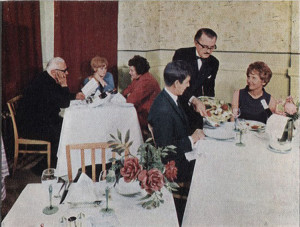
Well now for dinner. I browsed the menu, nothing jumped out at me so I asked the waitress for a suggestion. Out of the corner of her mouth she whispered “don’t ask for the turkey” as if she was telling me a state secret. Out of the corner of my mouth, so as to protect the integrity of our secret, I asked, “why not?”. “We don’t have any”, she whispered back. I then asked for another suggestion in my normal voice and she replied, again with a whisper out of the corner of her mouth, that the fish was good. It was then that I realized that not only did she have a speech impediment, but she was barking mad as well. The whole episode was right out of Fawlty Towers. Except that Fawlty Towers had not yet been written.
I had come down for dinner in a 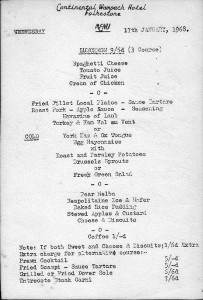 white polo neck sweater, very Carnaby St. Chose a table and sat down. Shortly the maître d’ came by and in a thick French accent said, “I am sorry M’sieur, but at zis ‘otel guests must wear ze jacket for dinnere”. I looked at him, I was puzzled. “Look Manuel, the hotel is empty; I’m the only guest staying here and it’s the middle of February.”, I said. “Ah well m’sieur, we could get bizzie”. Oh what the hey, when in Rome and all that. So I stormed off to my room and put on ze jacket and returned to the dining room. I had been away less than 10 minutes, but when I returned the dining room was completely full of guests. It seems that the local Manston Airport was fogged in and all the passengers were being put up in the Continental Wampach Hotel until the fog cleared. The rest of my stay was less eventful.
white polo neck sweater, very Carnaby St. Chose a table and sat down. Shortly the maître d’ came by and in a thick French accent said, “I am sorry M’sieur, but at zis ‘otel guests must wear ze jacket for dinnere”. I looked at him, I was puzzled. “Look Manuel, the hotel is empty; I’m the only guest staying here and it’s the middle of February.”, I said. “Ah well m’sieur, we could get bizzie”. Oh what the hey, when in Rome and all that. So I stormed off to my room and put on ze jacket and returned to the dining room. I had been away less than 10 minutes, but when I returned the dining room was completely full of guests. It seems that the local Manston Airport was fogged in and all the passengers were being put up in the Continental Wampach Hotel until the fog cleared. The rest of my stay was less eventful.
The Canteen
The factory in White Hart Lane, where I worked most of the time, had a canteen. The menu was simply this. Monday we had Roast Beef, Tuesday we had Cold Meat, Wednesday we had Shepherd’s Pie, do you see the picture? Thursday we had the shepherd and Friday was fish. Every week was the same. I made the mistake of asking the head cook if we could have something else on a Friday for a change. “Wha’s the matter wiv fish, it’s good fer yer brain?”, she replied curtly. Hmm, I thought, it’s obviously not working, I still eat here.
One time I found a pea in my dessert. I complained, tongue in cheek to the waitress, that the menu was wrong. It should have read rhubarb and pea pie. “If you don’t like it don’t eat ‘ere”, she shot back at me.
From time to time canteen diners would become ill from the food. I remember driving down a road not far from the factory and seeing one of my buddies turn into a house and knock rapidly on the door. I didn’t think he lived there and the next day he explained that he was walking to the bus and got “caught short”. Diarrhea had got him.
The Canteen Staff
I was a puzzle to the canteen staff. I didn’t have a cockney accent like the other guys. I was sort of better dressed, younger, single and better looking than most of my colleagues. I may have mentioned this before, but apparently I did somewhat resemble Hank Marvin, the guitar player from Cliff Richard and the Shadows. Not long a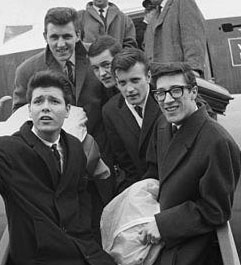 go my cousin Audrie sent me a photo of Hank Marvin from that era and sure enough there was more than a resemblance. I was also cockey and funny, a dangerous combo. And I had the Levy twinkle in my eyes. That twinkle would get me into a lot of trouble later on. Meanwhile back at the factory it was the job of the canteen staff to bring around the morning and afternoon tea and cookies. Most often these events were uneventful. But every so often, so as not to be boring, the canteen staff would do something odd. One day
go my cousin Audrie sent me a photo of Hank Marvin from that era and sure enough there was more than a resemblance. I was also cockey and funny, a dangerous combo. And I had the Levy twinkle in my eyes. That twinkle would get me into a lot of trouble later on. Meanwhile back at the factory it was the job of the canteen staff to bring around the morning and afternoon tea and cookies. Most often these events were uneventful. But every so often, so as not to be boring, the canteen staff would do something odd. One day 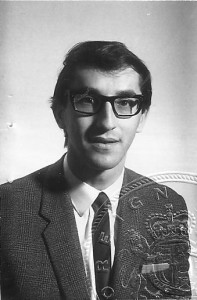 we had dish detergent in the sugar bowl. We were stirring our tea and getting quite a froth going. Another time I found cigarette ash floating in the milk in my cup. I pointed this out to the tea lady who said, “sorry luv”, wetted her finger in her mouth and stuck it in my cup and took it out. “Erm, er, can I have a cup without finger in it”, I pleaded, now preferring the ash and wishing I had kept my mouth shut.
we had dish detergent in the sugar bowl. We were stirring our tea and getting quite a froth going. Another time I found cigarette ash floating in the milk in my cup. I pointed this out to the tea lady who said, “sorry luv”, wetted her finger in her mouth and stuck it in my cup and took it out. “Erm, er, can I have a cup without finger in it”, I pleaded, now preferring the ash and wishing I had kept my mouth shut.
I remember Christmas time seemed to give the canteen staff leave to sneak up on any unsuspecting man, put mistletoe over his head and grab a kiss. The staff were a bunch of matronly, nut crunching, she-devils and I did my best to steer clear of them.
The Picture Show
Gestetner had several departments under one roof at the White Hart Lane factory. Apart from the offset machine repair division, it also housed the parts department and the offset plate making department. The plate making department contained the usual photographic equipment and a dark room. It was rather a large dark room and could easily fit 10 people in. It was there that the Gestetner plate making division held its Blue Movie Festival. “Blue movie” was the polite name given to hard core porn. They were generally 16 mm black and white films from the continent. Someone had access to a whole load of these movies and so, with some caution, a couple of times a week we had Picture Shows.
It was the best kept secret, known to only a privileged few special men and women. Yes it was a co-ed event. It was easy to tell when a blue movie had been shown; there wasn’t much work done afterwards and all the movie viewers had a glazed look about them. I don’t remember how many weeks the shows went on for, but no one was ever fired or suspended over it.
The Rebuilding Challenge
I was asked by my boss to rebuild about a dozen offset machines. They were all in a room at the back of the building. My job was to rebuild them so that they were ready for 4 colour overlay work. 4 colour overlay means that the paper has to go through the machine 4 times, once for each colour, red, cyan, yellow and black. I like a challenge and I didn’t mind working by myself. The challenge was to see how many machines I had to build before I could produce a machine that would work first time. The first challenge was to move the machines so that I could have a work space. No one wanted to help me move them. But.. I had a plan. I sprayed machine oil on the floor and slid all the machines into place. Of course I now had another problem, but I had a plan for that too. I’d leave a note for the cleaners.
One by one I rebuilt the machines, learning with each machine how to build the next machine so that it worked first time. Each machine had slight variations that I would make a mental note about and apply to the next machine. Eventually I did produce a machine that worked first time and no one believed me. Oh well! One thing I did learn was that a small, but important part of the training was wrong. I went back to my manager, Ron Leeson, and told him what I had found. It took a while to convince him but eventually he realized I was right. Now we had to tell John, the senior tech and trainer. John was not convinced. I showed him and he still said I was wrong. I said, “So you think you’re right”, he replied, “I don’t think….I know.”, “That’s what I’m saying”, I said appearing to agree with him, “I don’t think you know either”. He stormed out. Oh well. Back to my room.
Letraset
Letraset came out in the 60’s in the UK. It was a simple way to typeset short passages of text such as headings or in my case business cards.
I was getting quite good at using Letraset to create invitations etc.. So I decided to create my own calling card. It read “Russell Ross (quality Escort Service) available for weddings, barmitzvahs, first nights, last nights, honeymoons & bris.” It had my phone nu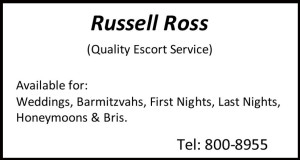 mber on it. It was of course, not meant to be taken seriously. However I did get invited to weddings and barmitzvahs and parties because of the card. I had included honeymoons because of an interaction I’d had with a customer when I worked on Saturdays at Brick’s Me
mber on it. It was of course, not meant to be taken seriously. However I did get invited to weddings and barmitzvahs and parties because of the card. I had included honeymoons because of an interaction I’d had with a customer when I worked on Saturdays at Brick’s Me
nswear in Lower Clapton Rd. London. A lady came into the store and asked me if we sold men’s swimsuits. I asked “what size is your man”, and she replied “men’s size”. I said, “lady you may not have noticed but men come in 3 size; small, medium and large”. Well they did in those days. Today it starts at large. She said, “well your size only larger”, I got out a medium size and she started to explain why she was buying them. Apparently her daughter was getting married and the newlyweds were going to Spain for their honeymoon. Seems the daughter liked to swim in the ocean and the husband didn’t so for safety’s sake they were bringing the best man as a swim buddy. Very smart thinking, even if a bit peculiar. “Will the best man be needing pyjamas”, I asked, with a cheeky grin. The woman didn’t know and would get back to me. I’d loved to have known the outcome.
It was now late August 1968, Rosh Hashanah was around the corner at the last week of September. It is the time of the year when we Jews are supposed to reflect on our behaviour and atone for our sins. It was a tradition in Judaism to send out New Year’s greeting cards to those near and dear. No matter the design on the front of the card, all New Year’s cards have the same greeting inside. “Sincere wishes for a Happy New Year and well over the Fast”. This year I decided to make my own New Year’s cards. After all I was adept at Letraset. I carefully typeset the greeting,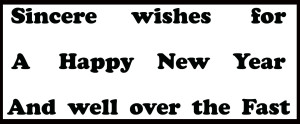 made the printing plate and ran off a few postcard size copies. They looked very smart but they weren’t “special”. But….I had a plan!
made the printing plate and ran off a few postcard size copies. They looked very smart but they weren’t “special”. But….I had a plan!
Gestetner had a thermography machine. This machine was like a large toaster that you see in restaurants. The toast goes in one end, travels along a conveyor and gets toasted. With thermography you have to sprinkle thermographic powder onto the printed material before it dries and the powder would stick to the ink. So I sprinkled black thermographic powder onto the card, tapped it to get rid of the excess and put it onto the thermographic conveyor. Out came the card with the raised text. It was perfect but not very New Yeary. The thermographic powder also came in gold and silver. So I dipped both ends of the card into the gold powder and placed it onto the conveyor. What came out made me laugh so hard 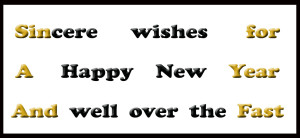 that I was having trouble breathing. If you read the part where the gold powder now existed it read, “Sin for a Year and Fast”. Which is pretty much what we all did but never admitted to.
that I was having trouble breathing. If you read the part where the gold powder now existed it read, “Sin for a Year and Fast”. Which is pretty much what we all did but never admitted to.
I was busy addressing these cards in my friend Howard’s office, when I first met Karen and her friend Glenda. And that is another story.
City Branch Service Manager
Eventually I was appointed Service Manager at The City branch. I had 3 servicemen working under me. In addition to trouble shooting it was also my job to manage the guys and make sure all the machines were serviced according to their agreements. It was pointed out to me by the branch manager that our service division had to be cost effective. That meant that we had to sign up service agreements and do a number of on-site refurbishments or over-hauls. Over-hauls were a good money maker. In addition the over-hauled machines required less service agreement calls. The challenge was that City machines worked almost day and night. The banks, stockbrokers and corporate head offices were where most of the Offset Machines were. These enterprises could not afford to have their machines out of use for two and a half to three days. Consequently we were continuously applying band aids to these ailing machines. But…. I had a plan. The Gestetner Offset Printing machines came in three main parts. The head which contained the cylinders which transferred the ink to the paper, the feeder system, where the paper was stacked and picked up by the suction feeder and the base which housed the motor and the delivery cylinder which took the papers from the print head and stacked them on a tray. It was the print head that always wore out first. The gears on the three cylinders were quickly worn down by paper dust which is highly abrasive. This caused the image on the paper to shift up or down the page. Not a big deal unless you’re doing more than one colour or you’re printing on to preprinted paper. The print head also contained the water and ink units with small gears that wore out even quicker. This affected the evenness of the ink on the paper. And now for my plan!
I had noticed that the machines all had serial numbers attached to their bases. What this meant was that we could complete an over-haul of a machine in two and a half hours. How was this possible? I hear you ask. Simple! We would assess the repairs necessary to bring the machine head up to standard and give the machine manager an estimate for the work. We would also assure the manager that the down time would be no more than two and a half hours. Essentially we would bring in a print head that had been previously overhauled in our branch, replace the existing print head and bring it back to the branch for over-hauling, ready for the next customer. Since the serial number was on the base and not on the head it was a piece of cake.
We did £6,000 of over-hauls in three months. I went to the branch manager and asked him for a bonus. He said “no”. So I quit. Everyone outside of the service department was quite happy to see me go. Especially the salesmen. It was a great plan but it had one pitfall. By refurbishing all the machines I had deprived Gestetner salesmen of selling new machines. Well no one’s perfect. Another good idea, didn’t work.
